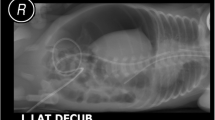Abstract
A male infant born at 26 weeks gestation became unwell at 10 days of age with blood-stained pharyngeal aspirates. The chest radiograph revealed a feeding tube in the right pleural cavity, indicating a perforation of the thoracic oesophagus. The infant had had a chest drain inserted on the right side on two previous occasions. These had been allowed to remain across the mediastinum at the site of the subsequent perforation. The infant was successfully managed conservatively with no long-term sequelae The unusual site of the perforation led us to conclude that pressure necrosis from the drains was a contributing factor in the aetiology.
Conclusion Oesophageal perforations in the neonate, in contrast to the adult, can be managed conservatively.
Similar content being viewed by others
Author information
Authors and Affiliations
Additional information
Received: 11 March 1997 and in revised form 24 February 1998 / Accepted: 3 March 1998
Rights and permissions
About this article
Cite this article
Cairns, P., McClure, B., Halliday, H. et al. Unusual site for oesophageal perforation in an extremely low birth weight infant. Eur J Pediatr 158, 152–153 (1999). https://doi.org/10.1007/s004310051037
Issue Date:
DOI: https://doi.org/10.1007/s004310051037




